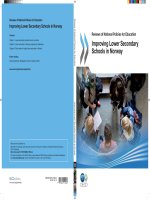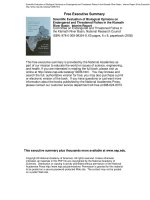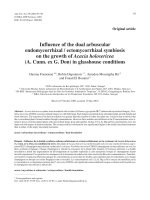Evaluation of bacterial endophytes for their plant growth promotion in vitro condition
Bạn đang xem bản rút gọn của tài liệu. Xem và tải ngay bản đầy đủ của tài liệu tại đây (563.28 KB, 9 trang )
Int.J.Curr.Microbiol.App.Sci (2019) 8(4): 2749-2757
International Journal of Current Microbiology and Applied Sciences
ISSN: 2319-7706 Volume 8 Number 04 (2019)
Journal homepage:
Original Research Article
/>
Evaluation of Bacterial Endophytes for their
Plant Growth Promotion in vitro Condition
P. Malakar*, D. Majumder, R.K. Tombisana and D. Thakuria
Central Agricultural University (Imphal), Umiam, Meghalaya- 793103, Meghalaya, India
*Corresponding author
ABSTRACT
Keywords
Bacterial
Endophytes,
Plant Growth
Promotion
Article Info
Accepted:
20 March 2019
Available Online:
10 April 2019
Endophytes are the micro-organism which shares the life long relation with the host. The
bacterial endophytes promote the growth directly and indirectly by several mechanisms.
Keeping in mind, the present investigation has been carried out to evaluate the bacterial
endophytes for their plant growth promotion in vitro condition. Four screened bacterial
antagonists viz., SVC 11, BE 1, NGB 21 and M1W1 were evaluated for the germination
and the vigour of French bean, brinjal and rapeseed mustard seeds. The bacteria were used
individual as well as in consortium mode on the respective seeds. The result revealed that
the seeds of French bean and brinjal treated with isolate NGB 21 as best in terms of
germination (91.11% and 84.44% respectively) and vigour (3270.88 and 1094.96
respectively) followed by BE 1. Isolate SVC 11 showed the highest vigour (630.51) at 21st
day and germination (84.44%) followed by the isolates NGB 21 and BE 1 in rapeseed
mustard. The root length and shoot length were significantly higher in French bean as
compared to brinjal and rapeseed mustard. Statistically the germination percentage and the
vigour index were found to be significant. The result showed that all the screened potential
bacteria have the best plant growth promoting ability as compared to the other crop seed
tested. Hence, the microbial consortia could be evaluated further under field conditions to
developed consortia against major vegetable pathogens of Meghalaya.
Introduction
Endophytes are the group of microbes may be
fungi or bacteria which asymptomatically
inhabit the internal tissues of plants; they
colonize the same ecological niches as
disease-causing organisms. Endophytes are
are known to control the plant diseases by
suppressing the pathogens but they also helps
in plant growth promotion. Some of the
mechanisms in plant growth promotion are
biological nitrogen fixation, ACC deaminase
synthesis, siderophore production, IAA
production,
phosphate
solubilization,
induction
of
host
plant
resistance
mechanisms, phytohormone production and
synthesis of pathogen inhibiting volatile
compounds (Glick, 2015). The seed play an
important role in agriculture . The overall
development of the plant depends upon the
seed germination and vigour of seeds.
Malfanova et al., (2011) tested the plant
growth promoting abilities of the bacterial
endophytes in tomato, wherein he isolated 30
2749
Int.J.Curr.Microbiol.App.Sci (2019) 8(4): 2749-2757
bacterial endophytes from different plant
species and evaluated against tomato foot and
root rot (TFRR). Of which, B. subtilis (HC8),
which was isolated from the giant hogweed,
significantly promoted the plant growth along
with giving protection against TFRR.
He indicated the production of metabolites
like gibberellin hormone, lipopeptide
antibiotics as possible mechanism for plant
growth promotion and disease suppression
respectively. Wahyudi et al., (2011) reported
the ability of Bacillus sp. to root length, shoot
length of seedlings (seed germination
biosssay) in vitro. Agrawal and Agrawal,
(2013) also isolated Bacillus strains from the
rhizosphere of tomato plants and screened for
their plant growth promoting activities. Five
isolates were selected and they showed
increased shoot and root length as well as
increased seed germination and seedling
vigour. The ability of Bacillus spp. on the
growth promotion in-vitro has been reported
by several workers (Wahyudi et al., 2011;
Agrawal and Agrawal, 2013; Malleshwari et
al., 2013)
Germination assay
Germination assay was performed on the petri
dishes (150mm diameter). The seed is surface
sterilized with 0.1% mercuric chloride for 3
min and washed with distilled water for 4-5
times. The seeds were soaked for 3h in 48 h
old bacterial broth cultures containing at least
10-6 cells/ml and placed in the Petri dish
containing the paper towel moistened with
water at the rate of 15 seeds per plate and
replicated 3 times. One treatment was carried
out by mixing the 4 bacterial cultures
(Microbial consortium). The seeds treated
with sterile water were served as control. The
plates were incubated at 28 ± 2o C and
moisture of the petri dishes was maintained
regularly.
Selection-9 variety of beans, KSP- 1164
Devansh variety of brinjal and variety of
Rapeseed Mustard were used for the present
investigation. The observations for percentage
seed germination were taken at 7 days after
incubation. The observations for root, length,
shoot length and vigour length was taken at 7,
14 and 21 days after incubation.
Materials and Methods
Inoculam preparation
Four endophytic bacteria used in this study
(SVC 11, BE 1, NGB 21 AND M1W1 ) were
isolated in the laboratory from different plant
tissues and stored at –80 °C in 20% (v/v)
glycerol. To prepare inoculam, 1 ml aliquot of
a bacterial culture grown overnight
(approximately OD600=1.0) were inoculated
in 20 ml nutrient broth (3 g beef extract, 10 g
proteose peptone, 5 g NaCl in one liter of
dH2O, pH 7.2) at 30 °C for 24 h with 150 rpm
shaking in rotary shaker. The individual
isolates were subjested for compatibilty test
and the microbial consortia was prepared by
mixing the bacterial growth in the aliquot.
Vigour index (Vi) = (RL + SL) × GP Where
RL = mean root length (cm) SL = mean shoot
length (cm) GP = germination percentage
(Gopalakrishnan et al., 2012).
Experimental
analysis
design
and
Statistical
The above experiment was designed in
completely randomized design (CRD).The
data were analyzed using one-way analysis of
variance (ANOVA). Statistical significance
between the treatments was compared using
LSD (Least significant difference) and a P
<0.01 was considered as significantly
different from the other treatments (Gomez
and Gomez, 1984).
2750
Int.J.Curr.Microbiol.App.Sci (2019) 8(4): 2749-2757
Results and Discussion
PGPB may affect plant growth either directly
or indirectly. The attributes contributing to the
promotion of plant growth includes
production of phytohormones like IAA
(Pattern and Glick, 1996), Giberrelic acid
(Mahmoud et al., 1984), Cytokinin (Tien et
al., 1979), production of ACC deaminase
enzyme, nitrogen fixation, solubilisation of
phosphate. The ability of Bacillus spp. on the
growth promotion in-vitro has been reported
by several workers (Wahyudi et al., 2011;
Agrawal and Agrawal, 2013; Malleshwari et
al., 2013). Four screened bacterial antagonists
were subjected for the compatibility among
themselves and n o lysis was observed at the
juncture of SVC 11, BE 1, NGB 21 and
M1W1 combinations, which indicated the
compatibility among the isolates. It was found
that seeds of French bean treated with isolate
NGB 21 recorded as best in terms of
germination (91.11%) and vigour (3270.88
atv 21 st day) followed by M1W1 (85.22%
and 2809.25, germination percentage and
vigour index respectively) and BE 1 (82.22%
and 2864.07, germination percentage and
vigour index respectively) (FIg. 1 and 2;
Table 1–3).
Table.1 Evaluation of screened endophytes for PGP activities in French bean seeds in vitro
Table.1.1 Observation on 7th day
setalosI
SVC 11
BE 1
NGB 21
MIW 1
MC
Control
eulav DC
Germination (%)
Shoot length (cm)
Root length (cm)
Vigour
77.78±2.23
82.22±1.67
91.11±1.55
85.22±1.88
97.78±1.33
73.33±1.28
5.56
1.33±0.11
1.40±0.42
1.70±0.12
1.37±0.23
2.03±0.19
1.13±0.11
0.43
10.6±0.05
11.0±0.07
11.7±0.12
10.33±0.17
12.2±0.17
9.5±0.14
0.25
928.14
1019.55
1217.85
956.51
1394.96
777.339
22.24
Table.1.2 Observation on 14th day
setalosI
SVC 11
BE 1
NGB 21
MIW 1
MC
Control
eulav DC
Germination (%)
77.78±2.23
82.22±1.67
91.11±1.55
85.22±1.88
97.78±1.33
73.33±1.28
5.56
Shoot length (cm)
9.53±0.04
9.6±0.07
9.83±0.14
9.53±0.18
10.27±0.12
9.33±0.42
0.34
2751
Root length (cm)
Vigour
14.4±0.23
14.8±0.45
15.76±0.14
14.26±0.17
16.23±0.13
13.6±0.55
0.35
1861.481
1897.778
2332.444
1904
2591.111
1630.815
22.24
Int.J.Curr.Microbiol.App.Sci (2019) 8(4): 2749-2757
Table.1.3 Observation on 21st day
setalosI
SVC 11
BE 1
NGB 21
MIW 1
MC
Control
eulav DC
Germination (%)
Shoot length (cm)
Root length (cm)
Vigour
77.78±2.23
82.22±1.67
91.11±1.55
85.22±1.88
97.78±1.33
73.33±1.28
5.56
18.9±0.06
18.93±0.09
19.±0.18
18.83±0.37
19.26±0.19
19.1±0.15
0.41
15.5±0.06
15.9±0.09
16.8±0.18
15.36±0.37
17.33±0.19
14.7±0.15
0.32
2675.556
2864.074
3270.889
2809.259
3578.667
2478.667
22.24
Table.2 Evaluation of Screened isolates for PGP activities in brinjal seeds In vitro
Table.2.1 Observation on 7th day
setalosI
SVC 11
BE 1
NGB 21
MIW 1
MC
Control
eulav DC
Germination (%)
Shoot length (cm)
Root length (cm)
Vigour
75.56±1.33
78.56±1.40
84.44±1.58
80.00±1.33
88.89±2.67
57.78±0.33
4.33
1.30±0.05
1.50±0.16
3.90±0.03
1.83±0.07
2.207±0.04
0.80±0.09
0.21
3.4±0.13
3.6±0.17
6±0.21
3.9±0.34
4.3±0.19
2.9±0.11
0.35
355.1111
362.6667
836
456
577.7778
230.2222
22.24
Table.2.2 Observation on 14th day
setalosI
SVC 11
BE 1
NGB 21
MIW 1
MC
Control
eulav DC
Germination (%)
Shoot length (cm)
Root length (cm)
Vigour
75.56±1.33
78.56±1.40
84.44±1.58
80.00±1.33
88.89±2.67
57.78±0.33
4.33
4.97±0.17
4.23±0.12
4.97±0.09
4.27±0.45
4.77±0.06
4.07±0.74
0.28
3.4±0.22
3.53±0.17
6±0.81
3.9±0.11
4.3±0.05
2.±0.12
0.41
632.1481
586.8148
926.0741
653.3333
805.9259
402.5185
33.43
2752
Int.J.Curr.Microbiol.App.Sci (2019) 8(4): 2749-2757
Table.2.3 Observation on 21st day
setalosI
Germination (%)
Shoot length (cm)
Root length (cm)
Vigour
SVC 11
75.56±1.33
5.87±0.33
4.57±0.16
783.2593
BE 1
78.56±1.40
5.13±0.19
4.7±0.22
699.2593
NGB 21
84.44±1.58
5.87±0.16
7.1±0.07
1094.963
MIW 1
80.00±1.33
5.17±0.11
5±0.25
813.3333
MC
88.89±2.67
5.67±0.29
5.43±0.15
986.6667
Control
57.78±0.33
4.97±0.41
4±0.17
557.9259
4.33
0.31
0.37
45.11
eulav DC
Table.3 Evaluation of screened isolates for PGP activities in rapeseed mustard seeds In vitro
Table 3.1. no noitavresbO7th day
setalosI
Germination (%)
Shoot length (cm)
Root length (cm)
Vigour
SVC 11
84.44±1.33
1.07±0.09
1.37±0.06
301.1852
BE 1
71.11±1.88
0.70±0.06
1.13±0.09
199.1111
NGB 21
78.11±1.58
0.80±0.03
1.57±0.18
227.5556
MIW 1
66.11±1.33
0.93±0.07
1.03±0.37
237.037
MC
88.89±1.67
2.17±0.09
1.00±0.19
459.2593
Control
68.88±1.33
0.57±0.09
1.23±0.15
190.5926
eulav DC
3.63
0.25
0.47
35.25
Table.3.2 Observation on 14th day
setalosI
Germination (%)
Shoot length (cm)
Root length (cm)
Vigour
SVC 11
84.44±1.33
2.3±0.13
2.5±0.11
405.3333
BE 1
71.11±1.88
1.9±0.88
2.1±0.04
275.5556
NGB 21
78.11±1.58
2±0.18
2.4±0.21
312.8889
MIW 1
66.11±1.33
2.1±0.13
2.4±0.34
322.3704
MC
88.89±1.67
3.37±01.7
3±0.19
565.9259
Control
68.88±1.33
1.77±0.33
2.2±0.12
273.2593
3.63
0.22
0.39
39.39
eulav DC
2753
Int.J.Curr.Microbiol.App.Sci (2019) 8(4): 2749-2757
Table.3.3 Observation on 21st day
setalosI
SVC 11
BE 1
NGB 21
MIW 1
MC
Control
eulav DC
Germination (%)
84.44±1.33
71.11±1.88
78.11±1.58
66.11±1.33
88.89±1.67
68.88±1.33
3.63
Shoot length (cm)
3.7±0.13
3.3±0.17
3.4±0.01
3.53±0.31
4.77±0.05
3.17±0.12
0.17
Root length (cm)
3.76±0.17
3.2±0.12
3.53±0.07
3.5±0.21
4.1±0.15
3.3±0.12
0.22
Fig.1 Germination percentage
Fig.2 Vigour index of the screened isolates
2754
Vigour
630.5185
462.2222
493.037
500.1481
788.1481
445.4815
42.33
Int.J.Curr.Microbiol.App.Sci (2019) 8(4): 2749-2757
Plate.1 Compatibility test of bacterial isolates
1
2
3
4
1
2
3
4
4
1.BG B4 2. BE-1 3. NGB 21 4.M1W1
Plate.2 Evaluation of the plant growth promoting (PGP) activities of screened bacterial
endophytes in vitro
1
(a)
(b)
(c)
2
(a)
(b)
(c)
3
(a)
(b)
(c)
a) Control b) Treatment with individual isolate c) Treatment with microbial consortia
1. French bean 2. Brinjal 3.Rapeseed mustard
2755
Int.J.Curr.Microbiol.App.Sci (2019) 8(4): 2749-2757
Plate.3 Root and shoot length after 21 days
(c)
(b)
(c)
1
2
(b)
(a)
(a)
(b)
(a)
(c)
3
a) Control b)Treatment with individual isolate c) Treatment with microbial consortia
1. Brinjal 2. Rapeseed mustard 3. French bean
In conclusion, isolate NGB 21 as best in terms
of germination and vigour. All the screened
potential bacteria has the best plant growth
promoting ability as compared to the other
crop seed tested. Hence, the microbial
consortia could be evaluated further under
field conditions to developed consortia
against major vegetable pathogens of
Meghalaya.
References
Malfanova, N., Kamilova, F., Validov, S.,
Shcherbakov, A., Chebotar, V.,
Tikhonovich, I., and Lugtenberg,
B. (2011). Characterization of Bacillus
subtilis HC8, a novel plant-beneficial
endophytic strain from giant hogweed.
Microb.Biotech, 4:523-532.
Glick, B.R., (2015). Beneficial plant bacterial
interactions. Springer International
Publishing,dnalreztiwS pp.243.
Agrawal, D.P.K., and Agrawal, S. (2013).
Characterization of Bacillus sp. strains
isolated from rhizosphere of tomato
plants (Lycopersicon esculentum) for
their use as potential plant growth
promoting rhizobacteria. Int. J. Curr.
Microbiol. App. Sci., 2(10): 406-417.
Wahyudi, A.T., Astuti, R.P., Widyawati, A.,
Meryandini, A., and Nawangsih, A.A.
(2011).
Characterization
of Bacillus sp. strains isolated from
rhizosphere of soybean plants for their
use as potential plant growth for
promoting rhizobacteria. J .Microbiol.
Antimicrob., 3: 34-40.
Malleswari, D., and Bagyanarayana, G.
(2013). In vitro screening of
rhizobacteria isolated from the
rhizosphere of medicinal and aromatic
plants for multiple plant growth
promoting activities. J. Microbiol.
Biotech, 3(1): 89-91.
Gopalakrishnan, S., Upadhyaya, H.D.,
Vadlamudi, S., Humayun, P., Vidya,
M.S., Alekhya, G., Singh, A.,
Vijayabharathi, R., Bhimineni, R.K.,
Seema, M., dna Rathore, A. (2012).
Plant growth-promoting traits of
biocontrol potential bacteria isolated
from rice rhizosphere. Springer plus.,
1(1): 71
Gomez, K.A., and Gomez, A.A. (1984).
Statistical procedures for agricultural
research. John Wiley and sons, New
York, pp. 680.
Mahmoud, S.A.Z., Ramadan, E.M., Thabet,
2756
Int.J.Curr.Microbiol.App.Sci (2019) 8(4): 2749-2757
F.M., and Khater, T. (1984).
Production of plant growth promoting
substances
by
rhizosphere
microorganisms.
Zentralbl.
Microbiol., 139: 227-232.
Patten, C.L., and Glick, B.R. (1996). Bacterial
biosynthesis of Indole-3-acetic acid.
Can. J. Microbiol., 42: 207-220.
Tien, T.M., Gaskins, M.H., and Hubbell, D.H.
(1979). Plant growth substances
produced by Azospirilum brasilense
and their effect on the growth of pearl
millet (Pennisetum americanum L.).
Appl. Environ. Microbiol., 37: 10161024.
Liu, X., Li, X., Li ,Y., Li, R., dna Xie, Z.
(2017). Plant growth promotion
properties of bacterial strains isolated
from the rhizosphere of the Jerusalem
artichoke (Helianthus tuberosus L.)
adapted to saline-alkaline soils and
their effect on wheat growth. Can. J.
Microbiol., 63(3): 228-237.
Hussain, M.I., Asghar, H.N., dnaAkhtar, M.J.
(2013).
Impact
of
phosphate
solubilising bacteria on growth and
yield of maize. Soil Environ., 32(1):
71-78.
How to cite this article:
Malakar, P., D. Majumder, R.K. Tombisana and Thakuria, D. 2019. Evaluation of Bacterial
Endophytes for their Plant Growth Promotion invitro Condition. Int.J.Curr.Microbiol.App.Sci.
8(04): 2749-2757. doi: />
2757









